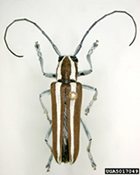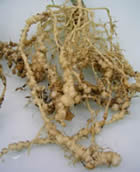
42nd Meeting of the Panel on Phytosanitary Measures
Paris, 2010-02-16/19
The Panel met in Paris. The main task of this Panel is to evaluate risks presented by specific pests and design phytosanitary measures to avoid their introduction and spread.
EPPO lists of pests recommended for regulation
On a case by case basis, the Panel reviewed PRAs prepared by the Expert Working Groups for PRA and performed pest risk management when necessary, and it also reviewed national PRAs. The Panel recommended to the Working Party the addition of Saperda candida to the A1 List, and of Meloidogyne enterolobiito the A2 List.
Two PRAs (on Epitrix damaging potato tubers and on Bactrocera invadens) are being finalized and the Panel considered that these pests would deserve rapid action. An e-mail and telephone consultation will be organized in order to review management measures and take a decision on their listing before the Working Party.
The Panel reviewed the present situation of A1 pests and recommended the transfer from the A1 to the A2 List of Bursaphelenchus xylophilus, Diaporthe vaccinii and Gibberella circinata.
The Panel reviewed the Action List and agreed that the following pests should be withdrawn as they have been on the Action List for more than 5 years (but they will remain on the A1/A2 Lists): Agrilus planipennis, Ips hauseri, Ips subelongatus, Sirex ermak, Xylotrechus namanganensis, Cucurbit yellow stunting disorder virus, Tomato chlorosis virus. Considering its rapid spread within the EPPO region, Tuta absoluta will be kept for another year on the Action List. The Panel also decided to highlight Citrus huanglongbing (citrus greening) (Liberibacter africanum, Liberibacter asiaticum, Liberibacter americanum) and its vectors Diaphorina citri and Trioza erytreae by adding them on the Action List.

Saperda candida
J. Solomon, USDA – forestryimages.org

Meloidogyne enterolobii
S. Kiewnick, Agroscope (CH)
Alert List
As usual, the Panel reviewed in detail the EPPO Alert List whose purpose is to warn countries about possible new risks, and in certain cases to propose candidates for PRA and eventually regulation. Considering that the alert had been given and that no further action was needed, the Panel decided to delete Leptocybe invasa, Nysius huttoni, Phaedon brassicae and Raoiella indica. The Panel suggested emerging pests that could be added to the Alert List (e.g. Diaphania indica, Keiferia lycopersicella, Thaumatotibia (=Cryptophlebia) leucotreta, Chrysophtharta bimaculata, maize redness, Trichodorus cedarus).
Pest Risk Analysis
The Panel considered documents and tools produced in the framework of the EU project PRATIQUE and made comments on them. In addition to the review of PRAs (see above) the Panel established the priorities for the organization of EWGs for PRA. The selection was made taking into account the following elements: geographical distribution, importance of the crop(s) concerned, risk of natural spread into the region or for further spread within the region, potential pathways, economic impact, environmental impact, possibilities of control, similarities to other known cases, availability and validity of data. The following pests were considered as having a high priority: Drosophila suzukii, Agrilus anxius, Keiferia lycopersicella, 'Candidatus Liberibacter psyllaurous'.
Candidate pests for re-evaluation
The Panel discussed the cases of Frankliniella occidentalis and Cacoecimorpha pronubana as candidates for deregulation. Recent data, in particular on pest distribution, is lacking and the Panel recommended that a questionnaire should be circulated to EPPO countries to gather updated information.
Follow-up of the EPPO Council Colloquium: Improving the plant health system
The Panel discussed how to improve the plant health system to better cope with emerging pests and increasing trade. It was agreed that more pathway analysis will be a good way forward, and the idea of initiating a pilot project on plants for planting from Asia was suggested which will be discussed further in the EPPO framework. The Panel also agreed that it was important to transfer more responsibility to growers and traders. Finally, harmonization of inspection procedures was identified as critical.
